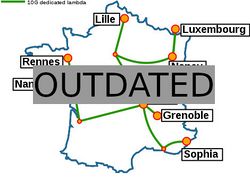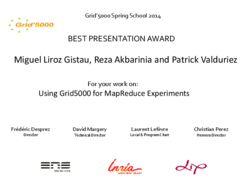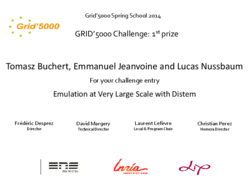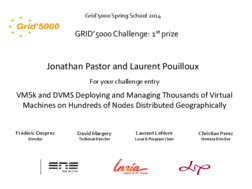Grid5000:Home: Difference between revisions
(move old news) |
No edit summary |
||
| Line 3: | Line 3: | ||
|- valign="top" | |- valign="top" | ||
|bgcolor="#f5fff5" style="border:1px solid #cccccc;padding:1em;padding-top:0.5em;"| | |bgcolor="#f5fff5" style="border:1px solid #cccccc;padding:1em;padding-top:0.5em;"| | ||
[[Image: | [[Image:renater5-g5k.jpg|thumbnail|250px|right|Grid'5000]] | ||
'''Grid'5000 is a large-scale and versatile testbed for experiment-driven research in all areas of computer science, with a focus on parallel and distributed computing including Cloud, HPC and Big Data.''' | |||
Key features: | |||
* provides '''access to a large amount of resources''': 1000 nodes, 8000 cores, grouped in homogeneous clusters, and featuring various technologies: 10G Ethernet, Infiniband, GPUs, Xeon PHI | |||
* '''highly reconfigurable and controllable''': researchers can experiment with a fully customized software stack thanks to bare-metal deployment features, and can isolate their experiment on the networking level | |||
* '''advanced monitoring and measurement features for networking and power consumption''', to provide a deep understanding of experiments | |||
* '''designed to support Open Science and reproducible research''', with full traceability of infrastructure and software changes on the testbed | |||
* '''a vibrant community''' of 500+ users supported by a strong technical team | |||
<br> | <br> | ||
''Grid'5000 is a scientific | Read more about our [[Grid5000:People|teams]], our [[Grid5000:Publications|publications]], and [[Grid5000:UserCharter|acceptable usage]] on the testbed. Then [[Grid5000:Get_an_account|get an account]], and learn to use the testbed with our [[Getting_Started|Getting Started tutorial]] and the rest of our [[:Category:Portal:User|Users portal]]. | ||
[[ | <!-- | ||
<br> | |||
Recently published documents: | |||
* Slides from Frederic Desprez's keynote at IEEE CLUSTER 2014 (FIXME) | |||
* Report from the Grid'5000 Science Advisory Board meeting (2014) (FIXME) | |||
--> | |||
<br> | |||
Grid'5000 is supported by a scientific interest group (GIS) hosted by Inria and including CNRS, RENATER and several Universities as well as other organizations. Inria has been supporting Grid'5000 through ADT ALADDIN-G5K (2007-2013), ADT LAPLACE (2014-2016), and IPL [[Hemera|HEMERA]] (2010-2014). | |||
|} | |} | ||
== Latest publications from Grid'5000 users == | |||
{{#publications:3||*}} | |||
<br> | |||
{{#status:0|0|0|http://bugzilla.grid5000.fr/status/upcoming.json}} | {{#status:0|0|0|http://bugzilla.grid5000.fr/status/upcoming.json}} | ||
==Latest news== | ==Latest news== | ||
=== [http://www.lifl.fr/~melab/HTML/Journee-G5K-Lille.htm Grid'5000 tutorial days in Lille] === | === [http://www.lifl.fr/~melab/HTML/Journee-G5K-Lille.htm Grid'5000 tutorial days in Lille] === | ||
| Line 33: | Line 51: | ||
|- | |- | ||
|} | |} | ||
--- | <!-- | ||
[[Grid5000: | === Journée Aramis === | ||
Le 16/04 aura lieu la journée Aramis "Usages et services du cloud dans notre environnement enseignement supérieur et recherche" avec une présentation de Grid'5000 par Simon Delamare. | |||
Cette journée est webcastée par la cellule Webcast du CC-IN2P3. Vous pouvez donc suivre en direct les [http://webcast.in2p3.fr/live/pleiniere_aramis_2014 présentations]. Le programme de la journée est disponible [http://aramis.resinfo.org/wiki/doku.php?id=pleniaires:pleniere17avril2014 ici] | |||
=== [[Grid5000:UserCharter|Grid'5000 Charter]] revised === | |||
The Grid'5000 charter has been reworded and simplified so as to be more inclusive about possible uses. The rules to ensure availability during the day for any user and during the night for large resource usage have not been changed. | |||
=== [[Grid5000:school2014|Grid'5000 school 2014]] announced === | |||
Organized in Lyon, from June 16th to June 19th 2014, this [[Grid5000:school2014|spring school]] will bring together, but is not limited to, Grid'5000's users, technical team and executive committee for 4 days of tutorials and talks focusing on best-practices and results. Presentations and practical sessions will cover both basic usage of the platform, for new users, or potential users of Grid'5000 and advanced and new usage of the platform, for current users. Deadline to submit presentation proposals is March 29th, 2014. | |||
=== Grid'5000 users win second prize at CCGRID 2013's SCALE challenge === | |||
==Grid'5000 at | Snooze based entry running on Grid'5000 entry wins [http://www.pds.ewi.tudelft.nl/ccgrid2013/awards/ 2nd prize] at [http://www.pds.ewi.tudelft.nl/ccgrid2013/ CCGrid 2013] [http://www.pds.ewi.tudelft.nl/ccgrid2013/calls/scale-challenge/ SCALE challenge]: well done Matthieu and Anne-Cécile for defending the entry titled ''Scalability of the Snooze Autonomic Cloud Management System'' by Eugen Feller, Christine Morin, Matthieu Simonin, Anne-Cécile Orgerie, and Yvon Jégou. | ||
=== Grid'5000 users finalists of the SCALE'2013 challenge === | |||
Two submissions (out of five) from Grid'5000 users took part in the final of the international SCALE'2013 challenge (held with CCGrid'2013): | |||
* D. Balouek, A. Lèbre, F. Quesnel Flauncher and DVMS -- Deploying and Scheduling Thousands of Virtual Machines on Hundreds of Nodes Distributed Geographically | |||
* Eugen Feller, Christine Morin, Matthieu Simonin, Anne-Cécile Orgerie, and Yvon Jégou -- Scalability of the Snooze Autonomic Cloud Management System. | |||
The first proposition presents the deployment and scheduling of thousands of virtual machines, conducted with the Flauncher and DVMS frameworks, across the Grid'5000 testbed. | |||
The frameworks have been able to deploy and schedule up to 10000 VMs during the tests. This research has been conducted in the context of the INRIA Hemera initiative. | |||
=== | The second proposition presents the Snooze architecture and focus on the following aspects : | ||
* System set up scalability and resources consumption, | |||
* Self-healing capabilities. | |||
The deployment of Snooze were distributed over several sites of the Grid'5000 testbed. | |||
The framework has been able to start 11000 of system services, recover thousands of failures | |||
and used to launch large hadoop/mapreduce experiments. | |||
This research has been conducted in the context of the INRIA Snooze ADT. | |||
=== Grid'5000 tutorial during ComPAS'2013 === | |||
The [http://compas2013.inrialpes.fr/ ComPAS'2013 conference] (replacing RenPar, SympA and CFSE), to be held in Grenoble between January 15th and 18th, will feature a Grid'5000 tutorial. | |||
--> | |||
---- | |||
[[Grid5000:News|read more news]] | |||
=== Grid'5000 sites=== | |||
{|width="75%" cellspacing="3" | {|width="75%" cellspacing="3" | ||
|- valign="top" | |- valign="top" | ||
|width="33%" bgcolor="#f5f5f5" style="border:1px solid #cccccc;padding:1em;padding-top:0.5em;"| | |width="33%" bgcolor="#f5f5f5" style="border:1px solid #cccccc;padding:1em;padding-top:0.5em;"| | ||
* [[Grenoble:Home|Grenoble]] | * [[Grenoble:Home|Grenoble]] | ||
* [[Lille:Home|Lille]] | * [[Lille:Home|Lille]] | ||
* [[Luxembourg:Home|Luxembourg]] | * [[Luxembourg:Home|Luxembourg]] | ||
* [[Lyon:Home|Lyon]] | |||
|width="33%" bgcolor="#f5f5f5" style="border:1px solid #cccccc;padding:1em;padding-top:0.5em;"| | |width="33%" bgcolor="#f5f5f5" style="border:1px solid #cccccc;padding:1em;padding-top:0.5em;"| | ||
* [[Nancy:Home|Nancy]] | * [[Nancy:Home|Nancy]] | ||
* [[Nantes:Home|Nantes]] | * [[Nantes:Home|Nantes]] | ||
* [[Reims:Home|Reims]] | * [[Reims:Home|Reims]] | ||
* [[Rennes:Home|Rennes]] | |||
|width="33%" bgcolor="#f5f5f5" style="border:1px solid #cccccc;padding:1em;padding-top:0.5em;"| | |width="33%" bgcolor="#f5f5f5" style="border:1px solid #cccccc;padding:1em;padding-top:0.5em;"| | ||
* [[Sophia:Home|Sophia-Antipolis]] | * [[Sophia:Home|Sophia-Antipolis]] | ||
* [[Toulouse:Home|Toulouse]] | * [[Toulouse:Home|Toulouse]] | ||
|- | |- | ||
|} | |} | ||
== Current funding == | == Current funding == | ||
Revision as of 22:38, 22 January 2015
|
Grid'5000 is a large-scale and versatile testbed for experiment-driven research in all areas of computer science, with a focus on parallel and distributed computing including Cloud, HPC and Big Data. Key features:
|
Latest publications from Grid'5000 users
Five random publications that benefited from Grid'5000 (at least 2780 overall):
- Prerak Srivastava, Antoine Deleforge, Archontis Politis, Emmanuel Vincent. How to (Virtually) Train Your Speaker Localizer. INTERSPEECH 2023, Aug 2023, Dublin, Ireland. hal-03855912v3 view on HAL pdf
- Geo Johns Antony, Marie Delavergne, Adrien Lebre, Matthieu Rakotojaona Rainimangavelo. Thinking out of replication for geo-distributing applications: the sharding case. ICFEC 2024: 8th IEEE International Conference on Fog and Edge Computing, May 2024, Philadelphia, United States. pp.1-8, 10.1109/ICFEC61590.2024.00019. hal-04522961 view on HAL pdf
- Maxime Gonthier, Samuel Thibault, Loris Marchal. A generic scheduler to foster data locality for GPU and out-of-core task-based applications. 2024. hal-04146714v2 view on HAL pdf
- Maurice Brémond, Hugo Brunie, Laurent Debreu, Rupert W Ford, Florian Lemarié, et al.. Poseidon: A Source-to-Source Translator for Holistic HPC Optimizations of Ocean Models on Regular Grids. SC 2024 - International Conference for High Performance Computing, Networking, Storage, and Analysis, Nov 2024, Atlanta (Georgia), United States. , pp.1-1, 2024, 10.5281/zenodo.11190458. hal-04811677 view on HAL pdf
- Félix Gaschi, Xavier Fontaine, Parisa Rastin, Yannick Toussaint. Multilingual Clinical NER: Translation or Cross-lingual Transfer?. 5th Clinical Natural Language Processing Workshop, Jul 2023, Toronto, Canada. pp.289-311, 10.18653/v1/2023.clinicalnlp-1.34. hal-04193182 view on HAL pdf
Latest news
Grid'5000 tutorial days in Lille
We are happy to let you known that tutorials around Grid'5000 will be organized in Lille on November 20th, 2014, with a few seats available for people outside Lille. All information on the dedicated web page.
Grid'5000 spring school now finished
The Grid'5000 spring school took place between June 16th, 2014 and June 19th, 2014 in Lyon. Three awards were given for presentation or challenge entries (the challenge entries ended as a tie):
|
Best presentation award to Miguel Liroz Gistau, Reza Akbarinia and Patrick Valduriez |
Best challenge entry to Tomasz Buchert, Emmanuel Jeanvoine and Lucas Nussbaum |
Best challenge entry to Jonathan Pastor and Laurent Pouilloux |
Grid'5000 sites
Current funding
As from June 2008, INRIA is the main contributor to Grid'5000 funding.
INRIA |
CNRS |
UniversitiesUniversity Joseph Fourier, Grenoble |
Regional councilsAquitaine |





